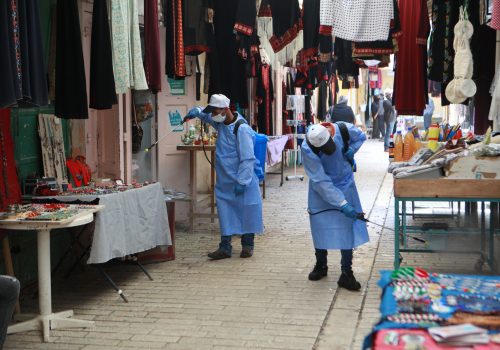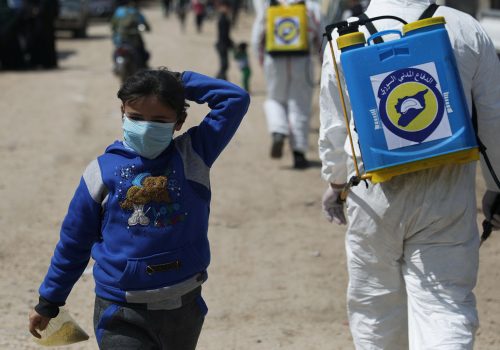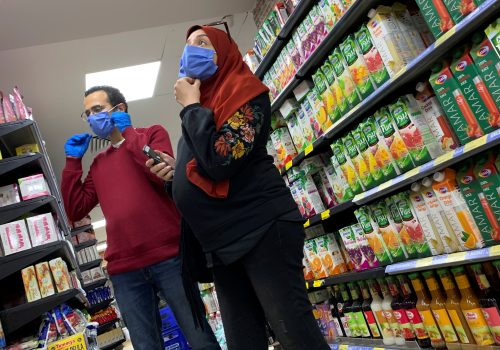Isolated Gaza reaches out for help to battle coronavirus
The nightmare prospect of a coronavirus outbreak in the densely populated refugee camps of the 25-mile Gaza Strip has galvanized international efforts to help Palestinians protect themselves from the global pandemic. Already cut off by land, sea and air blockades enforced by Israel and Egypt—who consider their Hamas leaders to be terrorists—2 million Gazans are burrowing into home isolation like the rest of the world in the hope they can ride out the threat despite their woefully insufficient medical facilities.
The accustomed tableau of black smoke billowing over Gaza from truck tires set aflame by protesters has been replaced by mute black flags hung from apartment balconies. In the age of COVID-19, Gaza’s rulers are tamping down the demonstrations and seeking the widest band of international assistance. Last week, thousands of face masks and testing kits arrived from the World Health Organization. The Gulf state of Qatar is sending $150 million in financial aid while broader international relief efforts are being coordinated by the Palestinian Authority, which helps administer Gaza despite having been violently thrown out of the territory in a 2007 Hamas coup. Expertise is even welcomed from Israel, whose Sheba Medical Center dispatched a disaster relief specialist to advise on epidemiological protocols.
March 30 marked the two-year anniversary of the “Great March of Return,” a protest movement against Israel’s blockade of Gaza, stoked by Hamas and the Iran-backed Islamic Jihad militant group that rallied Palestinian youths to storm the border fences by the hundreds each week in the face of gunfire from Israeli military snipers. Palestinian militants have also launched thousands of rockets into Israel and scorched fields at adjacent Israeli farms with flaming kites and balloons.
While not forgotten by Palestinians, the enduring conflict with Israel is taking a back seat to battling the coronavirus amid the terrifying recognition of what is at stake. Gaza’s dire poverty, poor sanitation, absence of clean water, and unreliable electricity paint a scenario of doom if more people start getting sick and dying. Hospitals are desperately short of beds, ventilators, medical supplies and doctors. So far, only 12 people have been diagnosed with COVID-19, while at least 1,700 have been placed in quarantine. Only 20 percent of those have been tested because emergency orders for examination kits and medical swabs haven’t arrived.
A humanitarian disaster looms if the virus spreads into Gaza’s crowded urban centers or any of its eight refugee camps where more than half the territory’s population lives in poverty and often squalid conditions, explained Sa’eed Salah, director of the intensive care unit at al-Durrah Hospital, to this author. “The death toll will be very high because we lack the needed medical supplies to face and combat such a horrible situation,” he added.
With that in mind, Gaza is likely to turn into a terrestrial petri dish that presents a fertile environment in which the coronavirus, once introduced, will breed and spread out of control. That possibility led the United Nations Middle East peace process coordinator, Nikolai Mladenov, to corral representatives from the White House, the Kremlin, the European Union, and international aid groups into a conference call to make sure that everybody was on the same page.
The good news is that Mladenov said cooperation between the Palestinians and Israel was “excellent” and that vital supplies were getting through to Gaza. The bad news is that the credibility of Hamas authorities is notoriously unreliable and could mask deficiencies in the coronavirus response, according to Grisha Yakubovich, a former official of Israel’s Coordinator of Government Activities in the Territories. Corruption and unreliable government statistics has long been an issue with international aid to the Palestinians, particularly in Gaza under Hamas.
For the most part, Hamas gets points for its generally professional handling of the crisis, including the start of construction on new quarantine facilities with 1,000 beds, said Yakubovich, but the governing authority is likely to fall back on propaganda if the situation worsens.
“People don’t trust their information,” he said to this author. “Often we find that the facts on the ground say something else.”
It’s worth noting that not all Gazans are taking COVID-19 seriously. At the end of March, pictures from a makeshift quarantine center showed people who were supposed to be isolated celebrating birthday parties with visiting relatives and even smoking water pipes together.
The biggest problem, though, is how ill-equipped Gaza is to handle the pandemic if it starts to spread, said Dr. Elhanan Bar-On, director of Sheba’s Israel Center for Disaster Medicine and Humanitarian Response, in a phone interview.
“The thing that characterizes disaster medicine in general is a complete imbalance between needs and resources,” noted Bar-On, who has been advising Palestinian doctors in the West Bank, East Jerusalem and Gaza on pandemic response.
“If this turns into big numbers, they’ll be completely overwhelmed,” he added. “At some point advice won’t be enough. They need swabs and testing gear.”
Jonathan H. Ferziger is a freelance writer who covered Israel, the West Bank and Gaza for more than 20 years as a reporter for Bloomberg News. Follow him on Twitter: @jferziger.
Saud Abu Ramadan in Gaza City contributed to this report.
Image: Workers pack food supplies to be distributed and delivered by the United Nations Relief and Works Agency (UNRWA) to the homes of Palestinian refugees as a precaution against the spread of coronavirus disease (COVID-19), in the northern Gaza Strip March 31, 2020 (Reuters)


